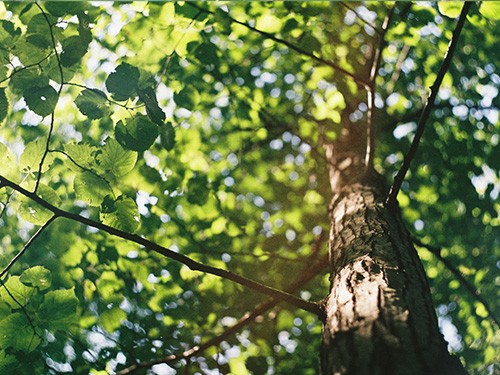Poplar Trees
As cellulose is considered the standard in biomass ethanol production, trees, which present the largest volume of potential biomass it makes sense to explore their resources. The process involves extracting sugars from the cell walls of plant material, or what is commonly known as biomass. Amongst this resource, one stands as the most viable option: Poplar or Populus trees. They grow rapidly, in various climates, soil conditions, and are very disease and insect resistant.
Not only that, but their hybrids can be easily planted, cultivated, harvested and replanted quickly producing a high yield for biomass production. They have been known to grow up to 15 feet in a year and up to 90 feet at only 6 years of age. They can also be harvested at any time of the year.
Biofuels expand beyond corn-based ethanol to woody biomass Poplar as a feedstock for biofuels: A review of compositional characteristics Ethanol industry eyeing poplar trees for fuelSwitchgrass
 
The grass is also resistant to drought and requires little, if any, fertilizer. This means that it requires less fossil fuel expended on production. Tractors used to spread fertilizer and provide fuel to the pumps that irrigate fields require fossil fuel. Less irrigation and less fertilizer means reduced energy input, which in turn means less cost and fewer greenhouse gas emissions. Switchgrass proponents also say that fuel produced from the plant would make the United States more secure and energy independent, as it could be grown in America and not have to be imported from other nations.
The alcoholic fuel produced from switchgrass feedstock—the raw material used to produce a distilled fuel—is cellulosic ethanol. This fuel is created during chemical process of breaking down the cellulose—the structure that makes up the plant’s cell walls. Once the cellulose is broken down into its basic components, yeast is added, and fermentation occurs. After it's refined, the resulting ethanol can be used as fuel.
The more cellulose available for extraction from a plant the more valuable it becomes as a source of ethanol. And switchgrass has lots of cellulose. Around 70 percent of the plant is composed of these complex carbohydrates. Even better, lignin—a byproduct created when water is eliminated from cellulose—has shown promise for use as a fuel to power ethanol production plants. If lignin can be harnessed, this could make ethanol processing self-sustaining.
Sources: United States Department of Agriculture Dept. of Agriculture - Farming For Fuel Ethanol Corn Vs Switchgrass HowStuffWorks.com - Grassoline: Can we fuel cars with grass? NCAT - Harvesting Clean Energy National Geographic - Biofuels
Photo: Wikipedia - Panicum Virgatum
Algae
Because it can be grown anywhere indoors, algae has the potential to rival other potential biodiesel products such as palm or corn.
Algae often have a much different makeup than most feed stocks used in ethanol, such as corn and sugar cane. Ethanol from algae is possible by converting the starch (the storage component) and cellulose (the cell wall component). Put simply, lipids in algae oil can be made into biodiesel, and the carbohydrates can be converted to ethanol. Algae are the optimal source for second-generation bioethanol due to the fact that they are high in carbohydrates/polysaccharides and thin cellulose walls.
Creating Ethanol from Algae
The fermentation process to produce ethanol from algae includes the following stages:
(a) Growing starch-accumulating, filament- or colony-forming algae in an aqua culture environment;
(b) Harvesting the grown algae to form a biomass;
(c) Initiating decay of the biomass;
(d) Contacting the decaying biomass with a yeast capable of fermenting it to form a fermentation solution; and,
(e) Separating the resulting ethanol from the fermentation solution.
Initiating decay means that the biomass is treated in such a way that the cellular structure of the biomass begins to decay (e.g., cell wall rupture) and releases the carbohydrates. Initiating decay can be accomplished mechanically or non-mechanically. The yeasts used are typically brewer’s yeasts (Saccharomyces cerevisiae and Saccharomyces uvarum). Besides yeast, genetically altered bacteria known to those of skill in the art to be useful for fermentation can also be used.
The algal biomass comprises three main components: carbohydrates, proteins, and lipids. Once the lipids have been extracted, the leftover cake is primarily composed of carbohydrates and proteins. The carbohydrates in the leftover algae can be converted into sugars, which, depending on the strain, can either be simple or complex. As a result, the leftovers can be used as feedstock for ethanol.
Algae cake that is left over after extraction of oil for biodiesel can be converted into ethanol through fermentation. This gives rise to the interesting possibility of producing both biodiesel and ethanol from algae. Add to this the fact that the fermentation of algae extract to ethanol releases carbon dioxide, which can be fed again in order to grow more algae. Such a closed loop presents an attractive potential on which some initial trials are ongoing.
This video illustrates how algae can be turned into fuel:
Sources: Oilgae - Ethanol Energy.gov - Bioenergy HowStuffWorks.com - How Algae Biodiesel Works
Trees
 
The technology involves oxygen-less burning of dead trees in order to generate hydrocarbon fuels and a byproduct known as biochar. This material can be added to agricultural lands to help capture carbon dioxide from the air, thus retaining moisture and enhancing soil quality.
Using the same gene-mapping tools created to probe the secrets of human DNA, plant geneticists in Oak Ridge and at the University of Washington are taking a closer look at the genes of fast-growing poplars. Upon discovering the genes responsible for traits such as height, drought tolerance, and pest resistance, researchers will be identify individual trees with high potential, cross them with other trees that excel in other traits, and then produce genetically identical copies in any quantity needed.
Sources: Oak Ridge National Laboratory - Bioenergy Technologies NBC - Trees killed by bugs eyed as biofuel for cars ISAA.org - Biotech Update
Photo: BioTech Photo

Related Videos

Related Videos

Related Videos

Related Videos
